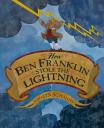Summary
How Ben Franklin Stole the Lightning by Rosalyn Schanzer is a creative and colorful biography of the life of Benjamin Franklin.
As the story begins, Schanzer runs through all of the different inventions and innovations that Franklin created in his life starting with his childhood. The inventions pile up and the reader begins to realize how much Ben Franklin did for society from inventing bifocals to the Franklin Stove and the musical armonica.
The book then focuses on how Franklin played with electricity and introduces the reader into the famous experiment involving the kite and the key. Schanzer captures the moment by saying
“Just as Ben and WIlliam were about to give up, the hair on that wet kite sting began to rise up and stand at attention. Ben put his knuckle near the key and YIKES!!!! Out jumped a bright sprk of genuine electricity! Real Lightning had traveled all the way down the kite string! Ben had stolen electric fire out of the heavens and proven that he was right.”
As the book finishes up it goes on to say how the results of Franklin’s experiment effected everyday society and prevented homes and ships from frequent fires.
Curriculum Connections
The students will work towards an understanding of electricity, electrical currents, light, and conductors. (SOL 4.3) Since this is a biography, this can also be tied into a history lesson plan.
Additional Resources
1. This is an introductory activity where students will learn the use of electricty and learn about its dangers.
2. This activity about electricity will help the students play with different materials and learn which ones conduct electrical charges.
3. This is an activity based on light pollution. It will help kids underatand how to reduce pollution in relation to electricity.
General Information
Book: How Ben Franklin Stole the Lightning
Author/Illustrator: Rosalyn Schanzer
Publisher: HarperCollins
Publication Date: December 2002
Pages: 40
Grade Range: 2-4
ISBN: 0688169937

